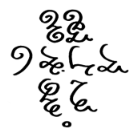Leaderboard
Popular Content
Showing content with the highest reputation on 06/24/2023 in all areas
-
Here comes the 3rd movement. I needed to post this so I can move on with my life lol. Links to previous movements. Hope you would enjoy and comment. Btw I should hold my promise, see if I can tag you @Awsumerguy1 point
-
Hi! Finally i started summer holydays so I'm able to compose as much as I want to! I wanted to try I new style, and I've been wondering about spanish classical music, I'm keen on folklore and culture so.. Why not trying it? It won't hurt anyone! (Well, it hurt my fingertips). I called this pieces after my birthplace, Córdoba, an Andalusian city where dance, flamenco, castanets and flower are everywhere... I would want to give a short explanation about spanish nationalism: - The usage of Andalusian cadence!!!!!! In a minor key i - bVII - bVIII - V, this cadence whas so popular that it was used among all world (https://youtu.be/cGufy1PAeTU, https://youtu.be/M6GK8HhjQQE this one is tricky, https://youtu.be/SrnWp5O0DEs) - Sections that are purely rythmical (https://youtu.be/SCKDG7w2S9c, https://youtu.be/fnvVFzV0yE0) - Circular melodies and motives - Dance rythms (https://youtu.be/q8rlFjWolvE) I really aim you all to check Albeniz's, Turina's and Falla's works! Must I add that i'm not a profesional pianist, I did as good i could, so please, if there are something not idiomatic or 'tecnically weird' please let me know! Córdoba.mp3 Córdoba.pdf1 point
-
I needed a break after the difficulties I had with the Piano Quartet Andante, and have been getting interested in the piano rep. I've been listening to Chopin, and found John Field in the process. His noctures were the beginnings (at least in name) for a genre that Chopin and others took up. Lovely stuff, though after 4 or 5, you get a little weary--something that I don't find with Chopin. Defintely worth a listen. Field's nocturnes aren't as elaborate or extemporaneous sounding as Chopin's, with the left hand pretty much providing arpeggiated accompaniment, and the right providing the melody. Not that they are simple--they are not--especially the later of the set of 18. I thought the project was striaght forward enough and doable, as well as providing an opportunity to write something I could play. Well, it started that way, but as will be seen/heard, by the time I worked it into a proper piece, it had quite gotten away from comfortable for me. Maybe with much work... Anyhow, I like to frame this as a rondo structure with A B A1 C A2 as the basis. The trick was to provide as much variety as possible with the ostenato accompaniment and sonics in general, so I raise the left hand part to treble at B, then changed the rising triplet to a broken chord pattern and left off with the pedal at C. It seems to provide a good amount of change/variety. The piece gets progressively more elaborate and adds more ornamentation and dramatics before closing. The climatic is at the melissma in the late C section--preserving the GOLDEN RATIO --CLIMAX at 2/3rds through the piece. I think the major key section has a bit of Chopin's improvisational sound--without his grace and perfection. Otherwise, it sounds like Beethoven and John Field met and had a baby (aspirationally, for me). Anyhow, I actually has some FUN with this, and completed it in 7 or 8 sessions over 3 weeks. I've heard some great music on the site lately, and know I owe some comments.. Now about ready for the PQ Allegro.... FINAL FORM! 😉 I've deleted the first submission and included here only the final edit. (Updated to v.F11R 6-28-23: performance of closing mini cadenza) 1. I've made chord corrections suggested by Henry and PCC. 2. The trill failing to register Eb and playing E nat. on the high note may be an error, but it sounds good as the chord resolves to A. Left as is. (Still need to research this issue though...) 3. ADDED: a dramatic fermata at the conclusion, with a unaccompanied melissima/run leading into the bass line ending. With the pedal is is very atmospheric and stark with the triplets disappearing. I spent a lot of time trying to get the performance right, and sounding a bit human. 4. Various cleanings up. EDIT 7-3-23 v.FR3 1. IMPROVED anacrusis at final return of A theme. Much better than first effort. 2. Further toning down of reverb to get a crisper treble/cleaner sound.1 point
-
It's your piece, I'm not here to dictate your moves, but it repeated diminished chords in a slow tempo can be very boring to me. I think you modified it a bit later? In any case things probably sound better in a real performance with appropriate voicing and such. I suppose that's why I insisted playing my own pieces. A dim7 chord does not need to be fulfilled only by the left hand. For example, bar 5, the C is supplemented by the melody. Of course there are a few ways you can go about for bar 5 as well. I will use Henry's magic against you here. Bar 7 C --> Bb caused a parallel from the arpeggio and the melody. After some thoughts 12/8 time signature wouldn't necessarily be limiting the polyrhythm potential if you do quadtuplets right, etc. then again I see these more as flourishes than true polyrhythms. Anyway, many good things said. And I have yet to get through nocturnes in general.1 point
-
Finally sat down to look at bar 3. Looking at it, this is an IDEAL example of what I am talking about regarding tonal ambiquity/flexibility using diminshed/7th chords in harmony. The chromatic anacrusis is leading into a G minor chord repeating the primary melodic minor key phrase. It is in itself playing on key indeterminancy to make its effect (moody/brooding). I SUPPORT it with an IMPLIED D7 (v7 with the root omitted) leading it G minor, ENHANCING the indeterminancy that this phrase is intended to induce. A clear D major hear would undermine to some extent the intended overall effect. I should note the D whole note undergirding the whole bar! Subtle, but important. Everything here (at least) is working in harmony (har har har). Every now and again I get it right. 😉 Along with a prior 1st inversion kerfluffle, I don't understand objections to any number of diminshed chords is they serve the needs of a piece. A minor key romantic adagio seems a likely place to find them. There are plenty of major, minor, and one or two augmented chords as well, and plenty of 7thd of all stripes, for those who are counting! Myself, I am against quotas!1 point
-
I really appreciate some of Sorabji's works, and this is definitely a much more tamed Sorabji. I think these types of piano works can really bring out an expression that typical "tonal works" have trouble with. As discussed in the Discord, I think that the actual 4 stave system may be really difficult to read as a performer, although there is a huge "cool factor" when you see the piano score broken up this way. And your sheet music is beautiful! I see you've pushed the limits of MuseScore, which is cool! You definitely have a theme / motif, that you are incorporating in these sketches, and it's hard for me to point this out on text. But if I decide to record parts of this piece, I will point them out on a video review. I think doing an "atonal" work like this might be kind of interesting for my channel. This way Music Jotter is not just "associated" with classical music. But overall, I think this atonal piece is actually a great introductory piece to listen to for those who want to venture into this style. You have the style down quite well in my opinion, and it is fairly well structured from what my ears are telling me at least. There are parts of the recording that need my "nuancing" touches though, because the louder sections are way too mechanical. But I think with my techniques, we can turn those sections into some pretty convincing recordings. PS: I thought I was the only one who knew of Sorabji. Glad to see he has another fan.1 point
-
One minutious revamp, two of Bach's favorite instruments, three dazzling voices - this piece has it all for me. The title is pretty much self-explainatory. Otherwise, please consider reading my YouTube video description here: Enjoy!1 point
-
Quite an interesting work mmmm I could think that there are more invention elements that you could add!1 point
-
Ahh yeah that too, just saw that That's a really interesting way of thinking about it. So if I understand correctly, you're taking the first 3 notes from the scales you mentioned, and putting them together to form a scale. Very interesting. I don't really know anything about octatonic scales, so I will look into that For sure! Thanks, Soroosh1 point
-
Yeah, and the Eb also clash with the E natural by the oboe in the last crotchet. That's a great try! Yeah they are all related within the same octatonic scale: D-E-F-G-Ab-Bb-B natural-C# and back to D, with D-E-F as D minor, F-G-Ab as F minor, Ab-Bb-B natural(Cb) as Ab minor, and B-C#-D as B minor. Thanks! Even a comment like "I love the piece" will help!! Henry1 point
-
Hi Henry, thank you! b14: I see what you're saying. The Eb does clash a bit with the D in the pizzicato cello a bit. I did borrow a chord from D dorian indeed, I really like the sound of a major IV chord in a minor context, there's something majestic about it. About the Fm, I think of that as a chromatic mediant, which is a concept I've been exploring a lot lately. Bm would be an interesting chord to try as well. If I'm not mistaking, that would be another chromatic mediant actually! I'll make sure to check out other members' posts as well. Like I said earlier, I'm not classically trained so my feedback might not be that useful for classical influenced music but I will give it a go 🙂 Thanks, Soroosh1 point
-
Hi @SorooshMHS, Welcome to YC and thanks for joining us! The piece is indeed beautiful. I agree with many things @Samuel_vangogh mentioned so I'm not going to repeat his points! I love the phyrgian mode in b.14 with the Eb, but I find its clash with E natural somewhat off. I think Soroosh does use the dorian scale, e.g. in b.16 with that E-B-E chord. I like in b.15-22 during similar passages you're alternating the chords with that dorian chord and the F minor (another octatonically related key!). Yup I agree with Samuel that the chord is chord is beautiful. Using octatonically related keys can be really beautiful sometimes! I agree with Samuel again. Besides his suggestion, using the B minor chord will be great too as it's the only octatonically key not being used here! But maybe for an incidental music the variety is enough here. Remember to check out our other members' posts and review them! Henry1 point
-
Hi! @Luis Hernández Thank you for your kind comment, i always liked folk music so i'm always in touch with it, i think i have a great musical intuition and it helps me compose 😅. But, piano is too hard for me and a i couldnt portray a lot of ideas i had in mind... Again, thanks a lot for your reply, it encourages me a lot to keep working!1 point
-
I see from your profile that you are Spanish. Well, whether you like it or not, that makes things easier. Because it is normal that anyone from a place, have in their historical memories the roots that correspond. I don't mean that we can write music fantasizing about distant cultural traditions, that's fine. On the other hand, the Andalusian cadence is something controversial. More than for what it is, which is clear to us, for how to theorize about it. I'm not going to delve into this now... "Córdoba" is a beautiful little piece of work. The beginning has a totally Andalusian flavor, both the introduction and the part up to measure 30. The part that follows it I think is more of a romantic style, very much in keeping with the time of the composers you mention, and in itself is a very nice mini-ballad that plays an important contrasting role. The final part strongly recovers the local flavor and is very successful. I congratulate you, because I liked it very much. ------ Y un poquito en español. Creo que adaptas el lenguaje de inspiración flamenco-andaluza al piano muy bien. y en tan poco tiempo creas una obra super interesante y completa. Saludos....... Luis.1 point
-
In bar 6: that Ab major chord sounds magical tto me, that chord doesnot make sense if we are thinking about D minor, but its easy to explain that chord as it is just cromatic notes, very well executed Bar 8, that F on a A7 chord may 'make the sonority muddy', idk if it was your intention. I love the harmonic progression in b15! When the oboe appears again with the melody in b23, its the same, maybe some melodic development or another harmonies would work as well, try writting an unexpected chord, this will add a lot of richness to the sonority. Also, try using dorian or mixolydian scales, they will help construct a more forestry sonority1 point
-
alrighty. so the project tempo is 100, 6/4 time, and here are the MIDI files: https://www.dropbox.com/s/ip1g3gmuhol0e3y/EvergreenWaltzMIDI.zip?dl=0 (sorry if it's multiple files and a bit messy, I've never really done midi exporting like this before)1 point
-
I think this is really cool! As for your concerns as to whether your piano writing is "idiomatic" or not, I would have thought looking at the score that you are a pianist, because nothing I see seems awkward to play. In fact, it looks downright easy, and I mean that absolutely as a compliment. (Real talk, though: maybe you're just joking about playing piano hurting your fingertips, but my PSA for the day for anyone reading this is that a person should NEVER feel pain during playing the piano at any point, ever. Not in the fingers, hands, arms, shoulders, back, etc. Tiredness and fatigue are normal, but pain means there is a fatal flaw in the piano playing technique you're using; I believe a lot of times it stems from tensing up during playing.) The piece is fine as it is: love it. Literally my only critique is that this prelude feels like it could benefit from being extended, or being part of a larger set of preludes. I mean, not everything needs to be developed in 20 different ways, and you've got famous preludes that are all of 30-40 seconds long. I think the reason I feel like this needs to be longer and more involved is because it has a dance-y, rhythmic angle to it, and such pieces typically thrive on being "well-developed". Even a 30-sec to a minute-long Coda section might give it that sense of completeness, for example. That's just my two cents. This is great, thanks for sharing! 🙂1 point
-
Hi @Samuel_vangogh, thank you so much for the feedback, glad you liked my piece! Yes I'd say this was incidental music. I wrote it for a challenge in a music community I'm in, where this was the prompt: "Create a music piece that expresses the feeling of being lost in a dense forest, surrounded by towering trees and the sounds of nature. The piece should have a sense of wonder, awe, and maybe a touch of uncertainty. The melody should be slow and melodic, with the use of soft strings and woodwinds to evoke the serene atmosphere of the forest. Percussive elements should be added to mimic the sounds of rustling leaves and the occasional bird call. The piece should build to a climax, reaching a state of peaceful acceptance before slowly fading away, leaving the listener with a sense of being one with nature." - I see what you mean with the rhythmic strings, it might have made it a bit more interesting. I kept most of my piece fairly simple haha - Just listened to that Herman Beeftink piece, it's really nice. I've definitely got a lot to learn about orchestration and will check out more of his work. Interesting that you thought my piece had celtic vibes, I don't think I've ever actively listened to that stuff 😄 - I don't have a score (a staff notation score that is), as that's not how I write music. I use MIDI piano roll in a DAW, so I could send MIDI if that would help! Thank you so much, Soroosh1 point
-
I see. I'm not talking about FX. I mean actually layering. like 3 different guitar parts, say, and 2 different violin parts for example. I guess that's not allowed. Makes sense, like you said, that would defeat the purpose of the challenge. Just wanted to make sure that's all1 point
-
That might be the most relatable thing I've seen on the site 🤣 I've listened to the whole sonata a few times now, and it's driving me crazy that I really just can't think of much to actually *say*. Maybe it'll come to me if I just start typing thoughts. First, you get gold stars for actually playing your piece -- in fact, the entire sonata. That's a lot of work! Composing is difficult enough, but performance is a related but decidedly distinct skill set. Bravo! I found this composition really challenging to understand, and it's finally dawned on me as to why that is. It's because there are elements of things in it (particularly in the first movement) that were written very much with your personal life being the key driving force, but it's paired along with writing that's detached from that mindset. There's probably a specific reason for the existence of mss. 17 - 18 in the 1st movement, (and it's later developments and iterations) because it has a somewhat naive quality that stands in stark contrast to the moodiness that surrounds it (almost like a loss of innocence, starting in ms. 23?). It's a jarring juxtaposition that's thrown me for a loop for a while, but now that I understand there's something of a personal meaningfulness to it for you, and there are sections that are derived from it without being connected to those personal things, I'm finally starting to wrap my head around it. I think for me, the highlight of the 1st movement is the daring but tasteful chords at places like mss. 66 - 67. For something practical, I'd say that at mss. 108-115, that second note in the L.H., the low F, just go ahead and move all of them, or at least most of them, an octave up, and the passage will likely look, feel, and sound more organic. That low F is rooting all the bass harmonies, and it sounds kind of "static" as a result, I think more than you intended. The second movement: I love the language here. It actually weirdly reminds me of Chopin's Op. 10 No. 6 Etude, or at least, it has a similar vibe to me. I really like it: the chromatic harshness and the gregorian chant part contrast well! The 3rd movement is really cool. My favorite part is the smoothness of the passages at mss. 107 - 100 and mss. 126 - 135. Thanks for sharing! I really enjoyed listening to all of this 🙂1 point
-
Yup, sorry for the unclean recording since the soundproofing of the room I recorded it is not that good. Henry1 point
-
Great piece! On a totally unrelated note: Is that a flute I hear in the background?1 point
-
Hey @PCC, That's a fascinating movement and playing for me! The movement looks monstrously hard for me, and even there are slips in your recording it doesn't mean anything for me. What's important is that you successfully realize your music to the world and share it to others! Congrats on that! The Scherzo I is indeed fiery. The fugal like counterpoint here is really funny and vary the texture here. I really love b.53, when you defy that Gb minor chord with one simple dominant chord. Amazing there. Maybe only b.23-24 I feel slightly off with the parallel fourths even though it comes from previous movements. Possibly adding a top voice with thirds btw the middle voice and sixth btw the lower voice to form a faxbourden will be great! For the trio I, is the theme come from a famous Christmas Song??!! I remember the tune is A-G-F#-E-D-E-F#-D and even the rhythm but I forget the name at the moment lol. But it combines with that fierce octaves with good effect. It's interesting that you use the tune with different harmonic progression there, and it's very creative to use this technique of re-harmonization. The beginning of the Trio II immediately reminds me the middle section of the third Scherzo of Chopin. I don't know the theme since I seldom play game lol. It's creative to include inversion in your double, but beware of the parallels like in b.266-267, And the ending is very brilliant! I like this! Thanks for sharing your work as well as your marvelous recording here. I really appreciate that! Henry1 point
-
Thx Vince and @SergeOfArniVillage for your compliments! I have to admit that I have never read through Vince's tempo markings for this one (sorry for infringing your absoulte authority as the composer haha), since as I've said in my comment, I feel like the tempo should be faster to make the piece funnier, and I'm happy my playing helps bring out the good, or the "charismatic mischievousness" as you say! But playing in a faster tempo does make some passages more dificult, like the wide leaps of LH and the unpredictable pattern in both hands. That's mischievous!! I will be continuing to play Vince's preludes for sure since they are lovely. Henry1 point
-
1 point
-
Hey guys. Here is a song I wrote and recorded for a challenge in a community I'm in. The task was to write a song that was an interpretation of this image (the one in the video). I performed the guitars and bass, and programmed everything else. I did some sound design on this too. What I ended up with was a progressive metal / post rock kind of sound. Love to know what you guys think! (PS: the production and tuning is a bit rough in some spots and I think I will rerecord this song)0 points



.thumb.jpg.e5f26b712b4f9622f521b10d8a53c6d6.jpg)




